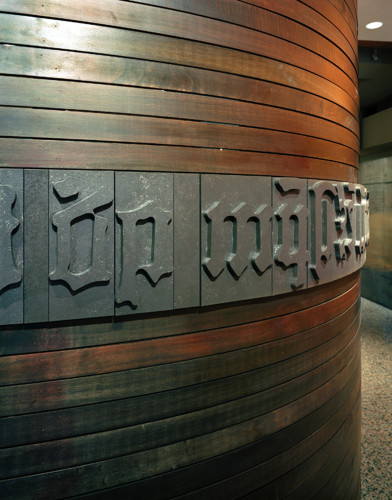
HRC Gutenberg Bible case
Pentagram, Austin, Texas, 2003
Description
The Harry S. Ransom Center of the University of Texas in Austin approached Pentagram with the challenge of displaying the Gutenberg Bible, the first book printed with movable type. The book is one of the greatest treasures in the center’s collections. It was printed at Johann Gutenberg's shop in Mainz, Germany, and completed in 1454 or 1455. The center’s Bible was acquired in 1978 and is one of only twenty-one complete copies in the world.
Historically, it is of major importance. Even so, as part of the center’s permanent collection, it couldn’t be showcased within the main gallery where temporary exhibits rotate through. The challenge was to give the Gutenberg Bible prominent treatment, hero status on a permanent basis.
Pentagram chose to locate the display between the center’s main entrance (front door) and the entry into the main gallery. The bible would be a permanent fixture within the center and, at the same time, on view as visitors and patrons came to see a new exhibit or opening.
Conceived as a physically interactive exhibit, the display case had to attract attention without intruding on the limited space around it or impeding access to the main gallery. The design goal was to achieve an environment that seemed to grow naturally out of an existing one. The architect selected a dark wood to match the gallery floor, thus uniting the display case in the foyer with the gallery space beyond. Furthermore, since the Gutenberg Bible represents the first use of movable type, the design represents the tactile quality of the letterpress process. We identified the exhibit using individual letters with a raised surface. The letters appear to be metal but are actually painted wood.
The new exhibit space opened in the spring of 2003 and is already attracting national acclaim. The center estimates that the number of visitors has dramatically increased since the exhibit was installed.
Juror Notes
Encased the artifact in a revelatory way, created a sacred space, its own environment. A deft handling of updating the old by using the old vocabulary in a modern context.
Credits
- Design firm
- Pentagram
- Creative director
- Lowell Williams
- Art director
- Lowell Williams
- Designers
- Kim Toda, Wendy Carnegie
- Photographer
- Thomas McConnell
- Project manager
- Kim Toda
- Architect
- Lake/Flato
- Curator
- Richard Oram
- Fabricator
- Austin Architectural Graphics
- Manufacturer
- Glasbau Hann
- Typeface
- Garamond
- Clients
- Harry Ransom Center, University of Texas



